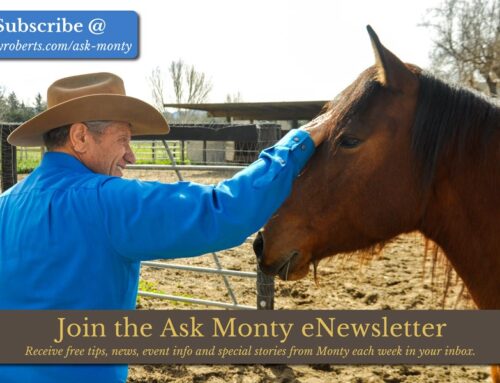Question:
Does Monty have a formula about how to achieve a light responsive mouth? Does he start riding in a halter, if so how long before he starts introducing a bit and would he still ride with the halter as well as a back up? Which bit does he start with? Which bits does he progress with and how much would he expect of a youngster at each stage of training the stop and turns and what to do if they start to lean on the bit? How much does ground work flexion and long-reining help with lightness and are there negative effects of starting off straight away in a strong bit, such as a Pelham, which would achieve quicker results?
Thanks,
Alice G., UK
Answer:
The process of causing a horse to accept the bit and bridle is known, in most of the horse world, as “mouthing” the horse. I have heard the procedure called “bit-ting” the horse, “bitting up” the horse and “schooling to the bit and bridle.” Whatever term you use for this procedure, it is causing the horse to accept communication from the hands of the rider through the reins, and ultimately the bit.
I call mouthing one of the most important procedures where training the young horse is concerned. It is critical to cause the horse to respond to cues from the reins and bit with the most subtle cues one can accomplish. The tissues over the bars of the horse’s mouth in the area of the corners are precious to any horseman. They should be treated with utmost respect as there is no second chance to create sensitivity once this area has been damaged during training.
We all want a sensitive mouth, but we are responsible for creating that sensitivity or destroying it. The bit is our partner in that effort. Regarding your question about ‘strong bits’ remember my constant admonition that there are no harsh bits. The only things that can be harsh about a bit are the hands that hold it. The well-trained horse with a properly fitted bit can have the reins tied on with fishing line and one should not have to worry about it breaking.
To start the young horse, however, I use the Dually Halter and teach the horse to respond to light rein pressure off the training rings on the Dually. I am also a proponent of mouthing the horse before saddling or riding. The definition of mouthing is to accustom the horse to bit and bridle (usually a snaffle). It is to cause the horse to be comfortable with wearing this device and responsive to being guided by it. It might seem strange to the reader who has seen my demonstrations to grasp this concept. I do not see the horses used in my demonstrations until the time of the event.
With a few exceptions, I don’t even know who owns them or where they come from. I want as much separation between myself and the horse as I can possibly have. This means that I would consider it inappropriate to even give instructions to the owner regarding mouthing.
To be given the chance to mouth a young horse before the start of saddling, bridling and riding is a high priority for me (outside of the parameters of a demonstration). For the past 40 years or so, I have taken every opportunity to acquaint the horse to the bit, bridle and reins before saddling and riding.
I am a strong advocate for using “black iron bits.” These were the normal bits for thousands of years before the advent of stainless steel. I find that horses prefer black iron and perform better with it than stainless steel. I further recommend that the black iron bit has copper inlaid in the mouthpiece. The combination of black iron and copper seems to me to be preferred by virtually every horse I work with.
I recommend that you accustom the horse to the surcingle, which can be accomplished in the round pen or even in a box stall. Once the horse can cope with the surcingle comfortably, I begin the process of mouthing. You should always take care not to have protrusions from the walls or fences of the enclosure you use for mouthing.
I will place a black iron snaffle with a brow band headstall appropriately on the horse’s head. You don’t need to have riding reins on the bit as a pair of side reins are used instead. The bit should sit in the horse’s mouth so that it effects a slight smile on the horse. Once the bit is touching the corners of the horse’s mouth, the handler should adjust it upward until it is about one-sixteenth of an inch higher than the corners would be in a natural state.
I suggest that the side reins be adjusted quite loosely at first. I recommend that the handler loose lunge the young horse in the round pen in sessions approximating 15 to 20 minutes in length. You can execute this event using all three natural gaits of the horse. It should be noted that exhaustion is not a part of training and you should be careful to monitor the horse’s comfort throughout the procedure.
After the horse has accepted the surcingle and the snaffle bit with loose side reins, the handler should then begin a process of shortening the side reins until the horse is nodding off the bit. Take care not to tighten before the horse is fully comfortable as he could object to the tension and potentially suffer injury by rearing or acting out in another negative fashion.
The side reins should be equipped with elastic to allow the horse a flexible tension and not a solid one. The handler might continue to loose lunge, creating impulsion by simply tossing a light driving line behind the horse to move him forward. Be sure the environment is safe. One should study the footing and the walls closely so as not to create an environment that could be dangerous for your animal.
After two to three sessions, you can often introduce driving lines using the side rings on the surcingle at approximately the same position where a rider’s knee might be. The handler should always be sensitive to how much work the young horse is doing and how he is accepting that work.
I recommend that mouthing should take place for 10 to 12 sessions before saddling and riding. The knowing handler will vary the length of time according to the needs of the horse. The nervous, fractious animal should be mouthed for a greater number of sessions than the quiet, cooperative one.
It is extremely important to use effective safety measures, only advancing when your equine student is fully prepared for it. I have provided an illustration here so that you can see each feature of the mouthing apparatus.
Many horsemen ask me how I suggest handling the horse that tosses his head while being rid-den and I tell them that this mouthing procedure can be employed. It is most likely that a bad set of hands has caused this problem. I have found it effective to allow the horse to toss his head, simply meeting the side reins and stretching the elastics.
Normally, horses will stop the head tossing after four or five sessions as recommended in this section. I have used this method of mouthing a horse for well over 50 years now and have found it to be most effective. When I finally saddle and ride the animal schooled in this fashion, it is amazing how cooperative he is with his turns, stops and reining back.
~ Monty
Monty’s Points:
I recommend the mouthing process whenever it is possible:
» Start mouthing in a round pen.
» Use a black iron bit with copper inlay.
» Use a long line with a surcingle and side reins.
» Use side reins with elastic.
» Do 10 to 12 sessions of mouthing before riding.
» Limit mouthing sessions to 20 minutes or less.
» Mouthing procedures can be used for horses that toss their heads.
» Safety is critical. Advance only when your equine student is ready.
GO TO: From From My Hands to Yours, Chapter 3 Building Trust





